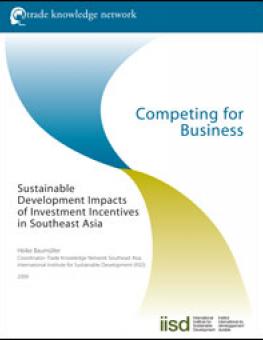
Competing for Business: Sustainable Development Impacts of Investment Incentives in Southeast Asia
Recent decades have seen a proliferation of investment incentives around the world, as governments seek to attract increasingly mobile foreign direct investment in the hope of spurring economic growth, raising employment and introducing new technology and know-how. This paper examines the effectiveness of such incentives in attracting FDI and promoting sustainable development in Southeast Asia. Drawing on existing research, the paper assesses the impacts of incentives on economic growth, government revenue, technology and knowledge spillovers, employment and environmental protection. The paper goes on to examine to what extent investment competition within Southeast Asia and with China has influenced the evolution of incentive policies in the region. Finally, the paper loks at how Southeast Asian governments have sought to regulate investment incentives through bilateral investment agreements and the Association of Southeast Asian Nations.
Key findings:
-
Incentive-based FDI competition—initiated by Singapore in the 1960s and emulated by its neighbours—has been identified as one of the key driving forces behind the proliferation of increasingly generous investment incentives offered by Southeast Asian countries. The most widely available incentives are tax incentives and reduced duties on capital goods and raw materials used in export-oriented production.
-
Incentives provided by Singapore, Malaysia and Thailand have played an important role in attracting FDI which in turn has spurred economic development and export growth. However, experiences in Southeast Asia have also shown that incentives are certainly not a sufficient condition for attracting FDI and a number of other factors—such as political stability, social and physical infrastructure, the macroeconomic environment and the level of institutional development—will be equally if not more important in shaping FDI decisions.
-
Local capacities and linkages to the domestic economy are important determinants for FDI to bring new technology and know-how to the recipient country. In Singapore and Malaysia, for instance, FDI constitutes an important source of new technologies. At the other end of the spectrum, technology spillovers have been limited in the region's least-developed countries.
-
In terms of employment generation, statistics suggest that FDI has helped to create jobs in Southeast Asia, in particular where FDI has served to expand the manufacturing sector. However, employment generation has not always been maximized, notably where investments have focused on capital-intensive sectors and where linkages to the local economy have been limited.
-
Liberalization of Southeast Asia countries' investment regimes has also been driven by concerns over FDI diversion to China. While China is likely to have diverted some FDI from Southeast Asia, several analyses have concluded that the "China effect" should not be overestimated. In some cases growing FDI inflows to China in fact have helped attract investment to some Southeast Asian countries that are part of the regional production network.
Key recommendations:
-
Whether the benefits of providing incentives in Southeast Asia have indeed outweighed the costs remains difficult to estimate. Importantly, the quantity of investments is not a sufficient indicator to judge the success of incentives. Understanding the complex interplay of incentives, FDI and sustainable development is crucial if governments are to move from reactive to proactive investment policy-making that can effectively use incentives to attract FDI and harness it for economic growth, social development and environmental sustainability.
-
The continued and accelerating economic integration of Southeast Asia through ASEAN, combined with the rapid growth of China, could place further pressure on governments to provide ever more generous incentives. However, the region has yet to move on adopting related provisions. In the longer term, region-wide regulations are needed to ensure that investment incentives benefit the region as a whole without distorting competition and inducing costly bidding wars. Increasing transparency and coordination of incentive schemes will be a prerequisite in this regard.
You might also be interested in
December 2024 | Carbon Minefields Oil and Gas Exploration Monitor
In November 2024, 23 oil and gas exploration licences were awarded across five countries, with Russia granting the licences that account for the largest portion of embodied emissions.
Toward a Coherent, Transformative Approach to Financing Sustainable Development, Climate, and Nature
Four key proposals for the Fourth Financing for Development Conference (FfD4) to create an integrated, equitable approach to financing climate, nature, and development goals.
Green Public Procurement in India
This report analyzes the status of green public procurement (GPP) in India and suggests key strategies for advancing sustainable procurement practices.
Sustainable Asset Valuation (SAVi) of a Small-Scale Tree Planting Initiative in Côte d'Ivoire
This report analyzes the social, economic, and environmental outcomes of a small-scale tree planting initiative at schools in Côte d'Ivoire.